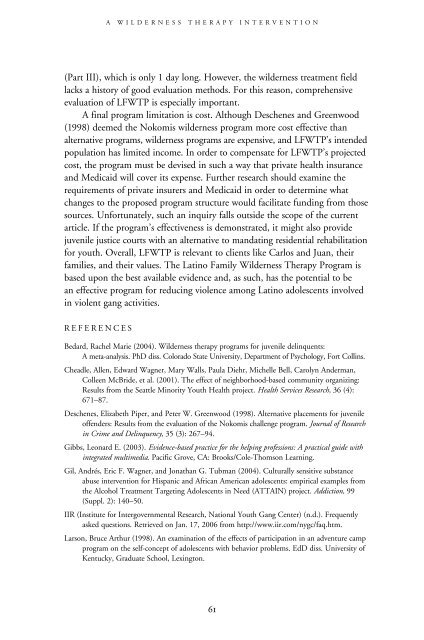2006 - School of Social Service Administration - University of Chicago
2006 - School of Social Service Administration - University of Chicago
2006 - School of Social Service Administration - University of Chicago
You also want an ePaper? Increase the reach of your titles
YUMPU automatically turns print PDFs into web optimized ePapers that Google loves.
A WILDERNESS THERAPY INTERVENTION<br />
(Part III), which is only 1 day long. However, the wilderness treatment field<br />
lacks a history <strong>of</strong> good evaluation methods. For this reason, comprehensive<br />
evaluation <strong>of</strong> LFWTP is especially important.<br />
A final program limitation is cost. Although Deschenes and Greenwood<br />
(1998) deemed the Nokomis wilderness program more cost effective than<br />
alternative programs, wilderness programs are expensive, and LFWTP’s intended<br />
population has limited income. In order to compensate for LFWTP’s projected<br />
cost, the program must be devised in such a way that private health insurance<br />
and Medicaid will cover its expense. Further research should examine the<br />
requirements <strong>of</strong> private insurers and Medicaid in order to determine what<br />
changes to the proposed program structure would facilitate funding from those<br />
sources. Unfortunately, such an inquiry falls outside the scope <strong>of</strong> the current<br />
article. If the program’s effectiveness is demonstrated, it might also provide<br />
juvenile justice courts with an alternative to mandating residential rehabilitation<br />
for youth. Overall, LFWTP is relevant to clients like Carlos and Juan, their<br />
families, and their values. The Latino Family Wilderness Therapy Program is<br />
based upon the best available evidence and, as such, has the potential to be<br />
an effective program for reducing violence among Latino adolescents involved<br />
in violent gang activities.<br />
REFERENCES<br />
Bedard, Rachel Marie (2004). Wilderness therapy programs for juvenile delinquents:<br />
A meta-analysis. PhD diss. Colorado State <strong>University</strong>, Department <strong>of</strong> Psychology, Fort Collins.<br />
Cheadle, Allen, Edward Wagner, Mary Walls, Paula Diehr, Michelle Bell, Carolyn Anderman,<br />
Colleen McBride, et al. (2001). The effect <strong>of</strong> neighborhood-based community organizing:<br />
Results from the Seattle Minority Youth Health project. Health <strong>Service</strong>s Research, 36 (4):<br />
671–87.<br />
Deschenes, Elizabeth Piper, and Peter W. Greenwood (1998). Alternative placements for juvenile<br />
<strong>of</strong>fenders: Results from the evaluation <strong>of</strong> the Nokomis challenge program. Journal <strong>of</strong> Research<br />
in Crime and Delinquency, 35 (3): 267–94.<br />
Gibbs, Leonard E. (2003). Evidence-based practice for the helping pr<strong>of</strong>essions: A practical guide with<br />
integrated multimedia. Pacific Grove, CA: Brooks/Cole-Thomson Learning.<br />
Gil, Andrés, Eric F. Wagner, and Jonathan G. Tubman (2004). Culturally sensitive substance<br />
abuse intervention for Hispanic and African American adolescents: empirical examples from<br />
the Alcohol Treatment Targeting Adolescents in Need (ATTAIN) project. Addiction, 99<br />
(Suppl. 2): 140–50.<br />
IIR (Institute for Intergovernmental Research, National Youth Gang Center) (n.d.). Frequently<br />
asked questions. Retrieved on Jan. 17, <strong>2006</strong> from http://www.iir.com/nygc/faq.htm.<br />
Larson, Bruce Arthur (1998). An examination <strong>of</strong> the effects <strong>of</strong> participation in an adventure camp<br />
program on the self-concept <strong>of</strong> adolescents with behavior problems. EdD diss. <strong>University</strong> <strong>of</strong><br />
Kentucky, Graduate <strong>School</strong>, Lexington.<br />
61
















